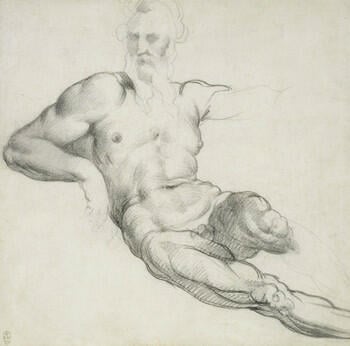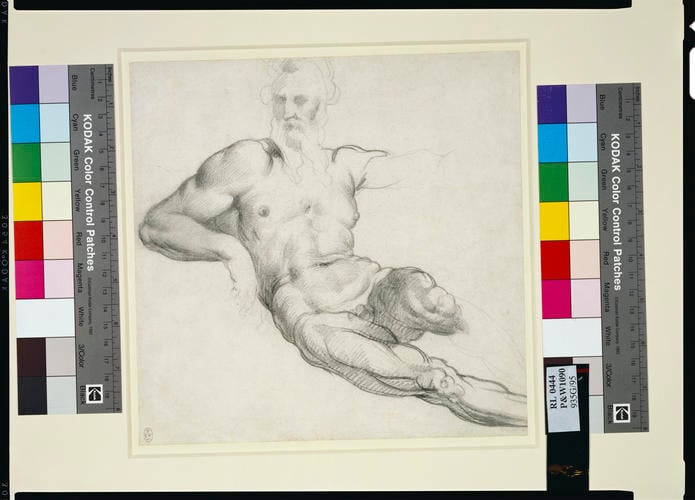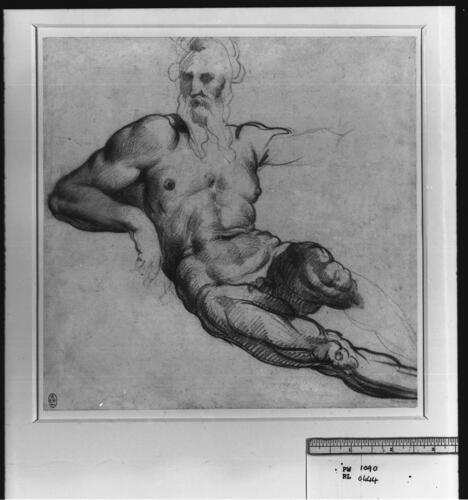-
1 of 253523 objects
A River God 1525-75
Black chalk | 22.4 x 22.5 cm (sheet of paper) | RCIN 990444
-
An unfinished drawing of a reclining river-god. The figure is similar in pose, build and facial type to the reclining river god in the lower left of Michelangelo's Fall of Phaethon (RCIN 912766), a figure itself developed in part from the river gods that Michelangelo intended to place in pairs at floor level either side of the ducal tombs in the New Sacristy (Medici Chapel) of San Lorenzo, Florence. This drawing's technique also reflects knowledge of the chalk drawings that Michelangelo made to prepare his most muscled allegorical figures for the New Sacristy, and was to develop further in his studies for the Last Judgement (eg. 912776 verso).
The artist of this splendid study has eluded secure identification. The powerful three-dimensionality of modelling suggests a sculptor and the face is reminiscent of the types favoured by Jacopo Sansovino, with lavish moustaches and flowing beards that combine to submerge their mouths. But the body appears more compact and rhythmical than those in Sansovino’s sculptures, and the drawing’s style bears little resemblance to those few drawings attributed to him. More attractive is an attribution to a sculptor by whom no figure drawings in chalk are securely identified, and arguably no figure drawings at all, Bartolomeo Ammanati. Although he later diverged from close imitation of Michelangelo’s forms, Ammanati was as a young man obsessed with Michelangelo’s work, to the extent of breaking into Michelangelo’s studio on via Mozza and stealing some of his drawings. Much of his sculpture of the 1530s and 1540s is modelled on Michelangelo’s designs. Ammanati worked in Venice in the early 1540s under Sansovino, carving spandrel figures of river gods for the Marciana library, figures in which the Michelangelesque inspiration is clear, and whose facial types are close to the present drawing and to Sansovino.
An attribution of the sheet to the young Ammanati would therefore conveniently explain those qualities that are reminiscent of both Michelangelo and Sansovino. Nonetheless caution is required. The musculature and pose of the figure in the drawing are so much more vital and mobile than Ammanati’s sculpted nudes, whose torsos are never as powerful, and whose torses tend to stiffness. The confidently vigorous application of chalk suggests a practised and fluent draftsman, and the manner in which the right arm and chest are modelled in soft strokes, carefully stumped to create a form that is dense and rotund but soft-textured, is reminiscent of the later manner of Francesco Salviati, whose drawings the present draftsman might have known.
Text adapted from P. Joannides, Michelangelo and his Influence. Drawings from Windsor Castle, Washington, D.C. 1996, no. 11. See also exh. cat. Firenze e la Toscana dei Medici nell'Europa del Cinquecento, Florence 1980, no. 25.Provenance
Provenance unknown, but presumably Royal Collection by 1800.
-
Creator(s)
-
Medium and techniques
Black chalk
Measurements
22.4 x 22.5 cm (sheet of paper)
Object type(s)


